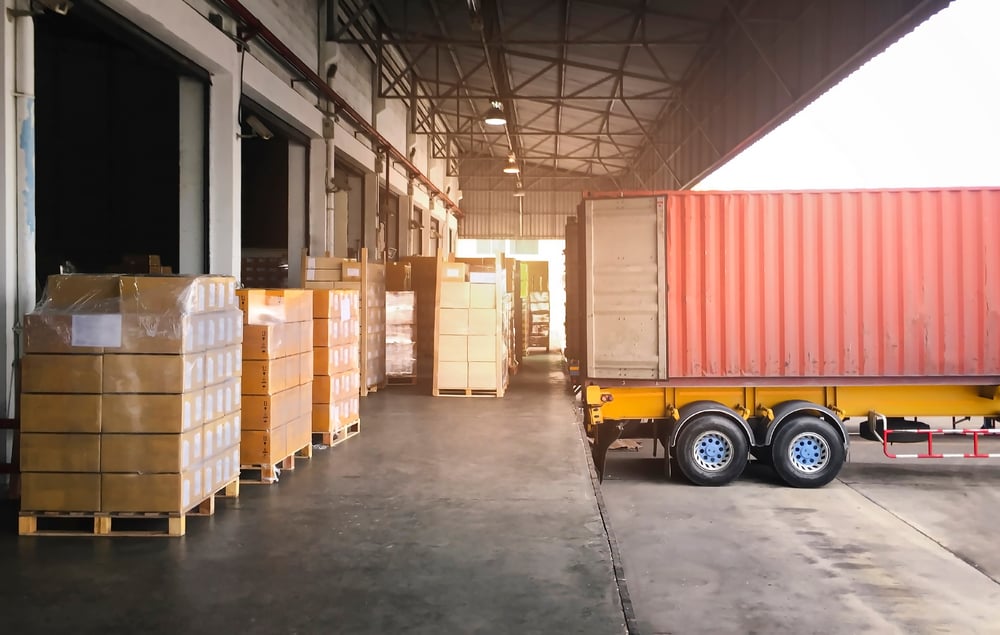How to Prepare Your Partial Load Trucking Ops for Peak Season Demand
As the seasons change, so do the demands on your partial load trucking operations. Preparing for peak demand is essential to ensure the success of your shipping company.
In this article, we'll discuss the key steps to help you navigate the challenges of seasonal shipping and optimize your operations to meet the increased demands.
The Benefits of Partial Load Trucking During Seasonal Shipping

Partial load trucking offers several advantages when it comes to seasonal shipping. Understanding these benefits can help you make informed decisions and optimize your operations during peak demand. Here are some key advantages of partial load trucking:
1) Cost Efficiency
Partial load trucking allows you to maximize the use of available space in your trucks. During seasonal peaks, you may not have enough freight to fill an entire truckload.
By combining multiple smaller shipments into a single truck, you can share the transportation costs with other shippers. This cost-sharing approach can significantly reduce your shipping expenses and improve your bottom line.
2) Flexibility
Seasonal shipping demands can be unpredictable, with varying shipment sizes and frequencies. Partial load trucking offers the flexibility to accommodate these fluctuations.
You can adjust the number of shipments you handle based on demand, ensuring you have the necessary capacity to meet customer needs. This flexibility enables you to efficiently scale your operations up or down, without committing to fixed truckloads.
3) Faster Transit Times
When it comes to seasonal shipping, time is of the essence. Customers expect timely deliveries, especially during peak periods. Partial load trucking can provide faster transit times compared to traditional LTL (Less Than Truckload) shipping.
By consolidating multiple shipments, you can streamline logistics and reduce handling and transit delays. This faster delivery time can give you a competitive edge and enhance customer satisfaction.
4) Environmental Sustainability
With increasing carbon emissions and sustainability concerns, partial load trucking can contribute to a greener supply chain. By optimizing truck capacity and reducing empty miles, you minimize fuel consumption and decrease the overall carbon footprint.
Embracing partial load trucking during seasonal shipping aligns with eco-friendly practices, which can enhance your company's reputation and attract environmentally conscious customers.
5) Improved Network Coverage
Collaborating with other shippers through partial load trucking can provide enhanced network coverage. By leveraging shared resources, you can reach more destinations and expand your reach without investing in additional vehicles or facilities. This expanded network can open up new business opportunities and help you better serve your customers during seasonal peaks.
Key Takeaway
By leveraging the benefits of partial load trucking during seasonal shipping, you can optimize your operations, reduce costs, improve efficiency, and enhance customer satisfaction.
Preparing Your PTL Fleet for Seasonal Shipping

Successfully managing partial load trucking operations during peak seasons requires careful planning and preparation. Here are key strategies to help you get your PTL (Partial Truckload) fleet ready for seasonal shipping:
1) Evaluate Your Current Fleet Capacity
Begin by assessing your existing fleet capacity and capabilities. Consider the number of trucks, their size, and payload capacity. Evaluate whether your current fleet can efficiently handle the anticipated shipment increase during the seasonal peak.
If necessary, explore options to expand your fleet through partnerships or rentals to temporarily meet the surge in demand.
2) Enhance Communication Channels
Effective communication is vital for smooth operations during seasonal shipping. Strengthen your communication channels with your customers and your internal team. Ensure your customers know any specific requirements or deadlines for placing orders during the peak season.
Internally, establish clear lines of communication between dispatchers, drivers, and other relevant stakeholders to streamline coordination and address any issues promptly.
3) Streamline Load Planning and Consolidation
Efficient load planning and consolidation are essential for maximizing truck capacity and minimizing empty miles. Implement robust load optimization software or systems that can analyze shipment data, identify synergies between different shipments, and consolidate loads effectively.
By optimizing load planning, you can minimize the number of trucks on the road, reduce fuel consumption, and increase overall operational efficiency.
4) Invest in Technology
Embrace technology solutions that can streamline your PTL operations. Consider implementing a transportation management system (TMS) to automate load tracking, order management, and invoicing processes. A TMS can provide real-time visibility into your operations, enable efficient route planning, and improve overall fleet management.
Additionally, leverage telematics and GPS tracking systems to monitor vehicle performance, enhance driver safety, and optimize delivery routes.
5) Collaborate with Partners and Carriers
Building strong partnerships with other shippers and carriers can be mutually beneficial during peak seasons. Explore opportunities to collaborate with other businesses that have complementary shipping requirements.
By sharing capacity and coordinating shipments, you can optimize truck utilization and reduce costs for all parties involved. Establishing reliable relationships with carriers can also help secure additional capacity when needed.
6) Conduct Driver Training and Support
Provide comprehensive training and support to your drivers to ensure they are well-prepared for the challenges of seasonal shipping. Train them on load securement, handling special cargo, and managing time-sensitive deliveries.
Encourage open communication with drivers and address any concerns they may have. Recognize their efforts and provide incentives to boost morale during demanding periods.
7) Monitor and Analyze Performance
Continuously monitor and analyze your PTL fleet's performance during seasonal shipping. Track key metrics such as on-time delivery rates, load utilization, and customer satisfaction.
Identify areas for improvement and implement corrective measures as necessary. Regularly review and adjust your strategies based on the insights gained from performance analysis.
Key Takeaway
By following these strategies, you can ensure that your PTL fleet is well-prepared to handle the demands of seasonal shipping efficiently.
Challenges You May Face During Peak Demand

While seasonal shipping brings opportunities for increased business, it also presents a set of challenges that you need to be prepared for. Awareness of these challenges can help you proactively address them and ensure smooth operations during peak demand. Here are some common challenges you may face:
1) Capacity Constraints
One of the primary challenges during peak demand is the limited capacity availability. The surge in shipping volumes may exceed your existing fleet's capabilities, leading to potential bottlenecks. It can be challenging to secure additional trucks or find carriers with available capacity.
Anticipate these constraints, establish relationships with backup carriers, or explore partnerships to mitigate capacity shortages.
2) Increased Competition
Seasonal peaks often attract heightened competition among shipping companies. With multiple businesses vying for limited resources, securing trucking capacity at reasonable rates can be challenging.
Be prepared to negotiate effectively and consider offering incentives or long-term partnerships to attract carriers and ensure capacity availability.
3) Time Sensitivity
During peak demand, the timeliness of deliveries becomes crucial. Customers expect their shipments to arrive on schedule, and any delays can negatively impact their operations. Managing time-sensitive deliveries requires meticulous planning, efficient routing, and effective communication with drivers.
Anticipate potential delays due to traffic congestion, adverse weather conditions, or other unforeseen circumstances and have contingency plans in place.
4) Fluctuating Demand
Seasonal shipping often involves fluctuating demand patterns. Predicting the exact shipment volumes and frequencies can be challenging, making planning and allocating resources difficult.
Stay agile and flexible in your operations, monitor market trends, and adjust your capacity and load planning strategies accordingly. Regularly communicate with customers to gather their forecasts and anticipate changes in demand.
5) Operational Efficiency
The increased shipping volumes during peak demand can strain your operational efficiency. Managing a higher number of shipments, coordinating multiple pickups and deliveries, and optimizing routes become more complex.
Utilize technology solutions such as transportation management systems (TMS) to automate and streamline your processes. Continuously monitor and fine-tune your operations to identify bottlenecks and improve overall efficiency.
6) Driver Shortages
Driver shortages can be exacerbated during seasonal peaks. Increased demand puts a strain on the availability of qualified and experienced drivers. Ensure you have a pool of reliable drivers who are adequately trained and prepared for seasonal shipping needs.
Implement retention strategies, such as competitive compensation, driver incentives, and a positive work environment, to attract and retain skilled drivers.
7) Customer Service Expectations
Customers have high expectations for service quality, regardless of the seasonal demand. Maintaining excellent customer service becomes even more critical during peak periods.
Ensure effective customer communication, provide timely shipment updates, and promptly address any issues or concerns. Establish clear service level agreements (SLAs) and manage customer expectations proactively.
Key Takeaway
By acknowledging and preparing for these challenges, you can navigate the complexities of peak demand more effectively.
Ensuring Timely PTL Delivery During Peak Seasons

Delivering shipments on time is paramount during peak seasons. Meeting customer expectations and maintaining a competitive edge requires careful planning and execution. Here are some tips to ensure timely PTL delivery during peak seasons:
1) Efficient Route Planning
Efficient route planning is crucial for optimizing delivery schedules and minimizing transit times. Leverage route optimization software or tools to determine the most optimal routes based on factors such as distance, traffic patterns, and delivery windows.
Consider the sequence of stops, loading and unloading times, and any special requirements for each shipment. Efficient route planning helps reduce mileage, fuel consumption, and driver downtime, ultimately ensuring timely deliveries.
2) Real-Time Tracking and Visibility
Implement real-time tracking and visibility systems to monitor the progress of shipments. This allows you to address any potential delays or issues during transit proactively.
Utilize GPS tracking technology to provide accurate and up-to-date information to customers regarding the location and estimated time of arrival of their shipments. Transparency and proactive communication build customer trust and enable them to plan their operations accordingly.
3) Effective Communication with Drivers
Establish effective communication channels with your drivers to ensure they have the necessary information and support to deliver on time. Provide them with detailed instructions, including delivery addresses, contact information, and any special handling requirements.
Regularly communicate with drivers to provide updates, address any concerns, and offer assistance when needed. Encourage open communication to resolve any unforeseen challenges during the delivery process promptly.
4) Prioritize Time-Sensitive Shipments
During peak seasons, it's crucial to prioritize time-sensitive shipments to ensure their timely delivery. Identify high-priority shipments and allocate appropriate resources to handle them efficiently.
This may include assigning more experienced drivers or dedicating specific trucks for expedited deliveries. By giving priority to time-sensitive shipments, you can meet critical deadlines and maintain customer satisfaction.
5) Collaboration with Carriers and Partners
Collaborating with carriers and partners can help you overcome capacity constraints and ensure timely deliveries. Maintain strong relationships with reliable carriers who can provide additional capacity when needed.
Consider establishing partnerships with other businesses or freight brokers who can assist in coordinating and consolidating shipments. Collaboration allows you to leverage shared resources and expertise, enhancing your ability to meet peak demand while delivering shipments on time.
Note: The Importance of Efficient Route Planning
Efficient route planning is critical to successful partial load trucking operations, particularly during peak seasons. Here's why efficient route planning is essential:
-
Minimizes Transit Time: Efficient route planning helps minimize transit times by optimizing the sequence of stops and reducing unnecessary mileage. By taking the most direct and time-efficient routes, you can ensure that shipments reach their destinations promptly. Minimizing transit time is crucial during peak seasons, as it allows you to handle a higher volume of shipments and meet customer expectations for timely deliveries.
-
Reduces Fuel Consumption and Costs: By optimizing routes, you can reduce fuel consumption and associated costs. Efficient route planning helps eliminate unnecessary detours, minimize idling time, and avoid congested areas. Reducing fuel consumption helps lower operating costs and contributes to environmental sustainability by minimizing carbon emissions.
-
Enhances Operational Efficiency: Effective route planning improves overall operational efficiency. You can streamline your operations and maximize truck utilization by eliminating inefficiencies, such as unnecessary backtracking or overlapping routes. This, in turn, allows you to handle a larger number of shipments during peak seasons without compromising on delivery times or incurring additional expenses.
-
Improves Customer Satisfaction: Timely deliveries are crucial for maintaining high levels of customer satisfaction. Efficient route planning ensures shipments arrive on time, enabling you to meet customer expectations and enhance their overall experience. Customers receiving their shipments as promised builds trust and loyalty, increasing the likelihood of repeat business and positive referrals.
Key Takeaway
Efficient route planning is crucial in optimizing partial load trucking operations during peak seasons. It minimizes transit times, reduces costs, enhances operational efficiency, improves customer satisfaction, enables better resource allocation, facilitates load balancing, and provides room for adaptability.
How Cargbot's Technology Can Help in Optimizing Seasonal PTL Operations

To optimize your seasonal partial load trucking (PTL) operations, consider leveraging the innovative solutions offered by Cargbot, a leading technology provider in the logistics industry.
Cargbot's advanced technology can address common challenges and enhance the efficiency of your operations during peak seasons. Here's how Cargbot's technology can benefit your business:
-
Load Optimization: Cargbot's advanced algorithms identify the most efficient load consolidation opportunities, maximizing truck utilization and reducing empty miles.
-
Route Planning and Optimization: Cargbot's tools provide real-time insights into the most efficient routes, minimizing transit times and improving on-time delivery performance.
-
Real-Time Tracking and Visibility: Cargbot's technology offers comprehensive visibility, allowing you to proactively address potential delays and disruptions.
-
Automation and Integration: Cargbot automates manual processes and seamlessly integrates with your existing systems, improving operational efficiency.
-
Analytics and Reporting: Cargbot's robust analytics provide valuable insights for optimizing operations and making data-driven decisions.
-
Collaboration and Network Expansion: Cargbot's platform facilitates collaboration with other shippers and carriers, expanding your network coverage.
By leveraging Cargbot's technology, you can streamline your seasonal PTL operations, optimize load planning and route optimization, enhance visibility and tracking, automate processes, and gain valuable insights for continuous improvement.
Ready to optimize your seasonal PTL operations with Cargbot's technology? Contact Cargbot today to learn how their solutions can benefit your business and schedule a demonstration. Don't miss out on the opportunity to enhance efficiency, improve customer satisfaction, and drive success in your seasonal shipping operations.
Learn more about finding the right PTL transport partner for your company with our free guide.
Start a discovery call with a Cargobot representative today!
More Resources to Explore:
- How to Choose the Best PTL Transport Solutions Partner
- 5 Ways Partial Truckload Companies Can Improve Their Supply Chain
- 5 of the Biggest Headaches Facing PTL Shipping This Year
- How PTL Shipping Companies Can Keep up w/ the Latest Technology Solutions & Demands
- 5 Ways Refrigerated Trucking Companies Can Keep Up w/ Industry Demands
- 5 Ways Partial Truckload Companies Can Improve Its Supply Chain


